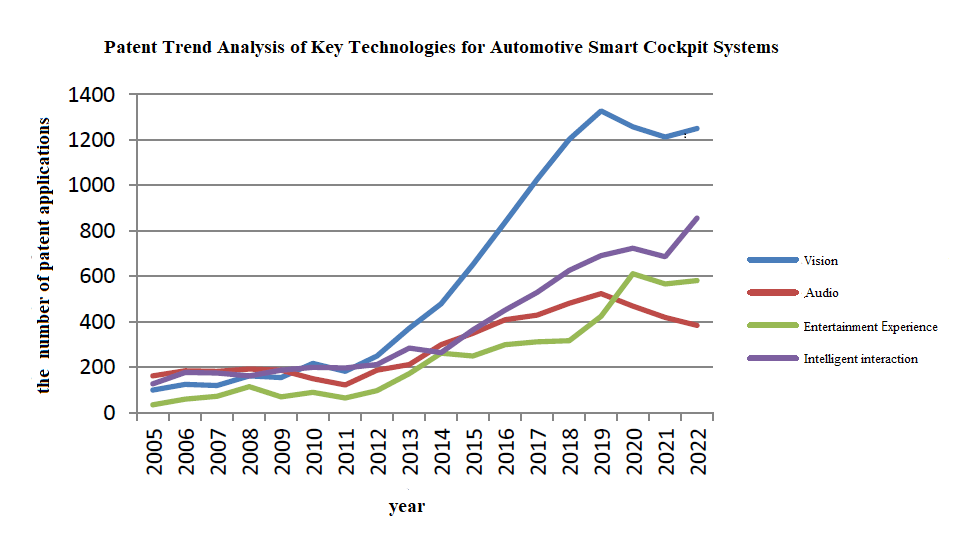In response to the growing popularity of the fifth generation of wireless technology, the approaching era of Vehicle-to-everything (V2X)and the rise in personalization requirements, the automotive industry has introduced the concept “smart cockpit.” To shed light on current developments in this field, the Taiwan Intellectual Property Office (TIPO) has recently released a report titled “Analysis of Patent Trends of Key Technologies for Automotive Smart Cockpit Systems,” which analyzes key technologies and trends in patent applications related to smart cockpit systems and provides relevant industry research and market information.
The report includes classification and analysis of technologies of smart cockpit systems from four technology sectors: vision, audio, entertainment experience and intelligent interaction. The key points are summarized as follows:
1. Vision - Technologies related to head-up displays
Applicants who applied for patent applications for vision technologies were mainly from Japan, the United States and mainland China. There has been a steady upward trend in the number of patent applications since 2013, except for a slight decrease in 2020. According to the statistics, traditional car manufacturers and automotive parts suppliers were the majority of the top ten applicants of patent applications filed from 2005 to 2022.
The 12,748 patent applications for vision technologies from 2005 to 2022 were mainly filed by applicants from Japan (3,895 cases, 31%), the United States (2,001 cases, 16%), mainland China (1707 cases, 14%), Germany (1,605 cases, 13%), South Korea (1,199 cases, 10%), and France (748 cases, 6%), while 162 patent applications were filed by applicants from Taiwan.
2. Audio - Technologies related to voice interaction, acoustic input and output, and acoustic environments
Applicants who applied for patent applications for audio technologies were also mostly from mainland China, the United States, and Japan. There has been an upward trend in the number of patent applications since 2011, and there has been a gradual decline since 2019. Despite the decline in the number of patent applications for audio technologies, there was an upward trend in the number of patent applications related to acoustic input technologies. According to the statistics, the top three applicants of patent applications related to audio technologies from 2004 to 2022 were Hyundai Motor (South Korea), Mitsubishi Electric Corporation (Japan), and Ford Motor Company (the United States). Patent applications for audio technologies were mostly filed by applicants from mainland China (1,377 cases, 26%), the United States (12,43 cases, 24%), and Japan (962 cases, 18%), while 69 patent applications were filed by applicants from Taiwan.
3. Entertainment- Technologies related to traditional entertainment experiences and immersive ride entertainment experience technology that integrates virtual and real environments
Applicants who applied for patent applications for entertainment experience technologies were mainly from the United States, mainland China, and the World Intellectual Property Organization (WIPO). There has been an upward trend in the number of patent applications since 2013, and the trend has slowed since 2020. However, there has been a significant upward trend in the number of patent applications for immersive entertainment experience technologies that combine virtual and real environments since 2018. According to the TIPO’s analysis, among the top ten applicants of patent applications related to entertainment experience technologies, in addition to the traditional car manufacturers and automotive parts suppliers, there are also several patent applications filed by V2X-related companies.
Applicants who filed patent applications for entertainment experience technologies were mainly from the United States (1,871 cases, 38%), mainland China (823 cases, 17%), and the WIPO (466 cases, 10%), while 69 patent applications were filed by applicants from Taiwan.
4. Intelligent Interaction - Technologies related to driver assistance systems, sleepiness and fatigue detection systems, occupant monitoring systems, and range anxiety reductions for electric vehicles
The majority of patent applications for intelligent interaction technologies were filed by applicants from mainland China, the United States, and Japan. There has been a steady upward trend in the number of patent applications since 2013, with a slight decrease in 2020. Except for technologies related to range anxiety reductions for electric vehicles, the top ten applicants in patent applications for intelligent interaction technologies are mostly traditional car manufacturers and automotive parts suppliers.
Patent applications for intelligent interaction technologies were mainly filed by applicants from mainland China (2,921 cases, 34%), the United States (1,883 cases, 22%), and Japan (850 cases, 10%).
According to the report published by the TIPO, there has been an upward trend in the number of patent applications related to smart cockpits, but there are currently no unified standards for technologies for smart cockpits. The report also includes all relevant inventions that can provide personalized and immersive experiences and can be applied to vehicle smart cockpits. Among patent applications for specific technologies, in addition to the traditional car manufacturers and automotive parts suppliers, a considerable number of applications have been filed by information and communication technology manufacturers.

(Summarized and translated from the News published on the TIPO’s website)
*Section Chief of International Patent Division at Tai E International Patent & Law Office







